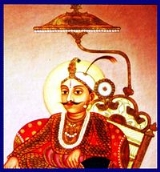
Narasaraja Wodeyar II
Encyclopedia
Kanthirava Narasaraja II (1704 - 1714 CE
), was the Wodeyar
ruler of the India
n state of Mysore
from 1704 to 1714 CE. He was born both mute
and deaf and came to be called Múk-arasu (literally "mute king"). He succeeded to the throne through the influence of the chief minister, Tirumalaiyangar. During his reign, his delavayi (chief of the army), who was also named Kanthirava, led an expedition to subdue Chik Ballapur, but was killed during the fighting. His son later took over and succeeded in establishing Mysore's suzerainty
.
Common Era
Common Era ,abbreviated as CE, is an alternative designation for the calendar era originally introduced by Dionysius Exiguus in the 6th century, traditionally identified with Anno Domini .Dates before the year 1 CE are indicated by the usage of BCE, short for Before the Common Era Common Era...
), was the Wodeyar
Odeyar
Odeyar/Wodeyar is a surname in Karnataka and Tamil Nadu.The word oDeyar is more popularly associated with the Royal Family of Mysore better spelled among English speaking as Wodeyers. However, it would be wrong to assume that this word is popular and typical to communities descended from or...
ruler of the India
India
India , officially the Republic of India , is a country in South Asia. It is the seventh-largest country by geographical area, the second-most populous country with over 1.2 billion people, and the most populous democracy in the world...
n state of Mysore
Kingdom of Mysore
The Kingdom of Mysore was a kingdom of southern India, traditionally believed to have been founded in 1399 in the vicinity of the modern city of Mysore. The kingdom, which was ruled by the Wodeyar family, initially served as a vassal state of the Vijayanagara Empire...
from 1704 to 1714 CE. He was born both mute
Muteness
Muteness or mutism is an inability to speak caused by a speech disorder. The term originates from the Latin word mutus, meaning "silent".-Causes:...
and deaf and came to be called Múk-arasu (literally "mute king"). He succeeded to the throne through the influence of the chief minister, Tirumalaiyangar. During his reign, his delavayi (chief of the army), who was also named Kanthirava, led an expedition to subdue Chik Ballapur, but was killed during the fighting. His son later took over and succeeded in establishing Mysore's suzerainty
Suzerainty
Suzerainty occurs where a region or people is a tributary to a more powerful entity which controls its foreign affairs while allowing the tributary vassal state some limited domestic autonomy. The dominant entity in the suzerainty relationship, or the more powerful entity itself, is called a...
.

